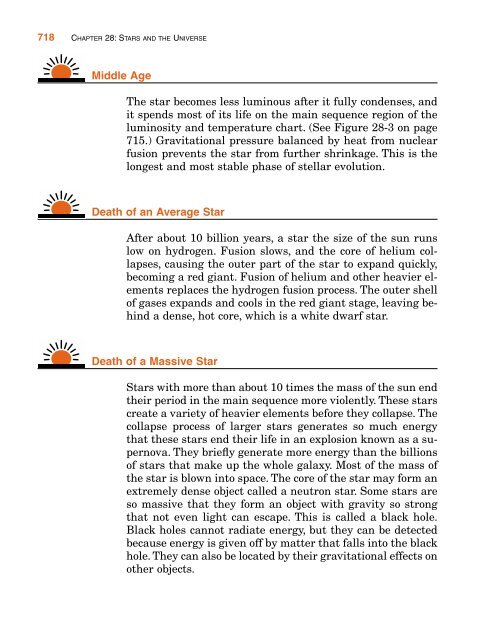Chapter 28 Stars and the Universe
Chapter 28 Stars and the Universe
Chapter 28 Stars and the Universe
You also want an ePaper? Increase the reach of your titles
YUMPU automatically turns print PDFs into web optimized ePapers that Google loves.
718 CHAPTER <strong>28</strong>: STARS AND THE UNIVERSE<br />
Middle Age<br />
The star becomes less luminous after it fully condenses, <strong>and</strong><br />
it spends most of its life on <strong>the</strong> main sequence region of <strong>the</strong><br />
luminosity <strong>and</strong> temperature chart. (See Figure <strong>28</strong>-3 on page<br />
715.) Gravitational pressure balanced by heat from nuclear<br />
fusion prevents <strong>the</strong> star from fur<strong>the</strong>r shrinkage. This is <strong>the</strong><br />
longest <strong>and</strong> most stable phase of stellar evolution.<br />
Death of an Average Star<br />
After about 10 billion years, a star <strong>the</strong> size of <strong>the</strong> sun runs<br />
low on hydrogen. Fusion slows, <strong>and</strong> <strong>the</strong> core of helium collapses,<br />
causing <strong>the</strong> outer part of <strong>the</strong> star to exp<strong>and</strong> quickly,<br />
becoming a red giant. Fusion of helium <strong>and</strong> o<strong>the</strong>r heavier elements<br />
replaces <strong>the</strong> hydrogen fusion process. The outer shell<br />
of gases exp<strong>and</strong>s <strong>and</strong> cools in <strong>the</strong> red giant stage, leaving behind<br />
a dense, hot core, which is a white dwarf star.<br />
Death of a Massive Star<br />
<strong>Stars</strong> with more than about 10 times <strong>the</strong> mass of <strong>the</strong> sun end<br />
<strong>the</strong>ir period in <strong>the</strong> main sequence more violently. These stars<br />
create a variety of heavier elements before <strong>the</strong>y collapse. The<br />
collapse process of larger stars generates so much energy<br />
that <strong>the</strong>se stars end <strong>the</strong>ir life in an explosion known as a supernova.<br />
They briefly generate more energy than <strong>the</strong> billions<br />
of stars that make up <strong>the</strong> whole galaxy. Most of <strong>the</strong> mass of<br />
<strong>the</strong> star is blown into space. The core of <strong>the</strong> star may form an<br />
extremely dense object called a neutron star. Some stars are<br />
so massive that <strong>the</strong>y form an object with gravity so strong<br />
that not even light can escape. This is called a black hole.<br />
Black holes cannot radiate energy, but <strong>the</strong>y can be detected<br />
because energy is given off by matter that falls into <strong>the</strong> black<br />
hole. They can also be located by <strong>the</strong>ir gravitational effects on<br />
o<strong>the</strong>r objects.

















